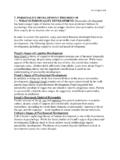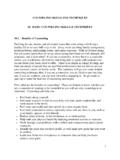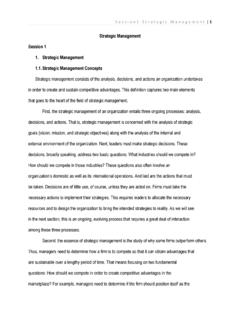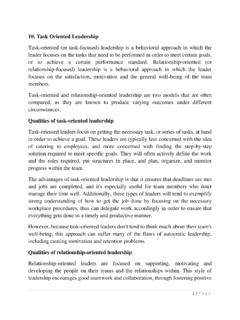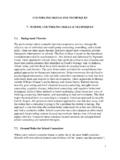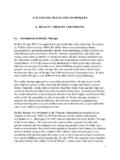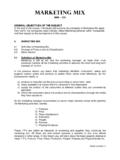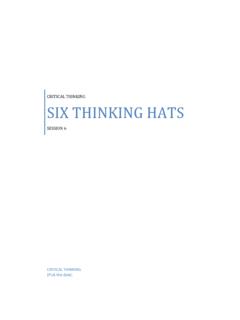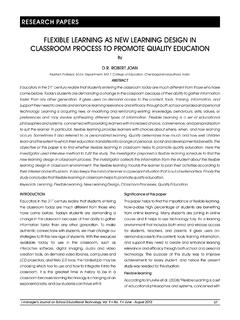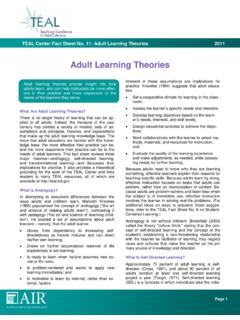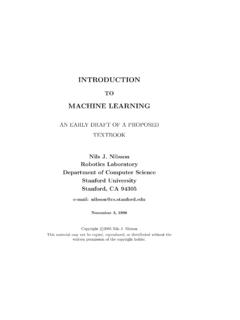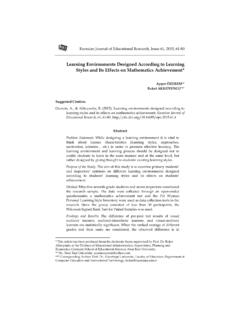Transcription of THEORIES OF LEARNING 1. LEARNING THEORIES OVERVIEW …
1 1 THEORIES OF LEARNING 1. LEARNING THEORIES OVERVIEW Background of LEARNING THEORIES LEARNING THEORIES are conceptual frameworks that describe how information is absorbed, processed, and retained during LEARNING . Cognitive, emotional, and environmental influences, as well as prior experience, all play a part in how understanding, or a world view, is acquired or changed, and knowledge and skills retained. Behaviorists look at LEARNING as an aspect of conditioning and will advocate a system of rewards and targets in education. Educators who embrace cognitive theory believe that the definition of LEARNING as a change in behavior is too narrow and prefer to study the learner rather than their environment, and in particular the complexities of human memory.
2 Those who advocate constructivism believe that a learner's ability to learn relies to a large extent on what they already know and understand, and that the acquisition of knowledge should be an individually tailored process of construction. Transformative LEARNING theory focuses upon the often necessary change that is required in a learner's preconceptions and world view. Outside the realm of educational psychology, techniques to directly observe the functioning of the brain during the LEARNING process, such as event related potential and functional magnetic resonance imaging, are used in educational neuroscience. As of 2012, such studies are beginning to support a theory of multiple intelligences, where LEARNING is seen as the interaction between dozens of different functional areas in the brain, each with their own individual strengths and weaknesses in any particular human learner.
3 The term behaviorism was coined by John Watson. Watson believed that theorizing thoughts, intentions or other subjective experiences was unscientific and insisted that psychology must focus on measurable behaviors. For behaviorism, LEARNING is the acquisition of a new behavior through conditioning. Conditioning There are two types of conditioning: Classical conditioning - The behavior becomes a reflex response to stimulus. 2 Operant conditioning - There is reinforcement of the behavior by a reward or a punishment. Classical conditioning, was noticed by Ivan Pavlov, when he saw that if dogs come to associate the delivery of food with a white lab coat or with the ringing of a bell, they will produce saliva, even when there is no sight or smell of food.
4 Classical conditioning regards this form of LEARNING to be the same whether in dogs or in humans. Operant conditioning, or radical behaviorism, reinforces this behavior with a reward or a punishment. A reward increases the likelihood of the behavior recurring, a punishment decreases its likelihood. Behaviorists view the LEARNING process as a change in behavior, and will arrange the environment to elicit desired responses through such devices as behavioral objectives, competency-based LEARNING , and skill development and training. Educational approaches such as applied behavior analysis, curriculum-based measurement, and direct instruction have emerged from this model.
5 Cognitivism Cognitive THEORIES grew out of Gestalt psychology, developed in Germany in the early 1900s and brought to America in the 1920s. The German word gestalt is roughly equivalent to the English configuration or pattern and emphasizes the whole of human experience. Over the years, the Gestalt psychologists provided demonstrations and described principles to explain the way we organize our sensations into perceptions. Gestalt psychologists criticize behaviorists for being too dependent on overt behavior to explain LEARNING . They propose looking at the patterns rather than isolated events. Gestalt views of LEARNING have been incorporated into what have come to be labeled cognitive THEORIES .
6 Two key assumptions underlie this cognitive approach: that the memory system is an active organized processor of information and that prior knowledge plays an important role in LEARNING . Cognitive THEORIES look beyond behavior to consider how human memory works to promote LEARNING , and an understanding of short term memory and long term memory is important to educators influenced by cognitive theory. They view LEARNING as an internal mental process (including insight, information processing, memory and perception) where the educator focuses on building intelligence and cognitive development. The individual learner is more important than the environment. Once memory THEORIES like the Atkinson-Shiffrin memory model and Baddeley's working memory model were established as a theoretical framework in cognitive 3 psychology, new cognitive frameworks of LEARNING began to emerge during the 1970s, 80s, and 90s.
7 Today, researchers are concentrating on topics like cognitive load and information processing theory. These THEORIES of LEARNING play a role in influencing instructional design. Cognitive theory is used to explain such topics as social role acquisition, intelligence and memory as related to age. Constructivism Built on the work of Jean Piaget and Jerome Bruner, constructivism emphasizes the importance of the active involvement of learners in constructing knowledge for themselves, and building new ideas or concepts based upon current knowledge and past experience. It asks why students do not learn deeply by listening to a teacher, or reading from a textbook.
8 To design effective teaching environments, it believes, one needs a good understanding of what children already know when they come into the classroom. The curriculum should be designed in a way that builds on what the pupil already knows and is allowed to develop with them. Begin with complex problems and teach basic skills while solving these problems. This requires an understanding of children's cognitive development, and constructivism draws heavily on psychological studies of cognitive development. The LEARNING THEORIES of John Dewey, Maria Montessori, and David Kolb serve as the foundation of constructivist LEARNING theory. Constructivism has many varieties where active LEARNING , discovery LEARNING , and knowledge building are three, but all versions promote a student's free exploration within a given framework or structure.
9 The teacher acts as a facilitator who encourages students to discover principles for themselves and to construct knowledge by working to solve realistic problems. Transformative LEARNING Theory Transformative LEARNING theory seeks to explain how humans revise and reinterpret meaning. Transformative LEARNING is the cognitive process of effecting change in a frame of reference. A frame of reference defines our view of the world. The emotions are often involved. Adults have a tendency to reject any ideas that do not correspond to their particular values, associations and concepts. Our frames of reference are composed of two dimensions: habits of mind and points of view.
10 Habits of mind, such as ethnocentrism, are harder to change than points of view. Habits of mind influence our point of view and the resulting thoughts or feelings associated with them, but points of view may change over time as a result of 4 influences such as reflection, appropriation and feedback. Transformative LEARNING takes place by discussing with others the reasons presented in support of competing interpretations, by critically examining evidence, arguments, and alternative points of view. When circumstances permit, transformative learners move toward a frame of reference that is more inclusive, discriminating, self-reflective, and integrative of experience.
